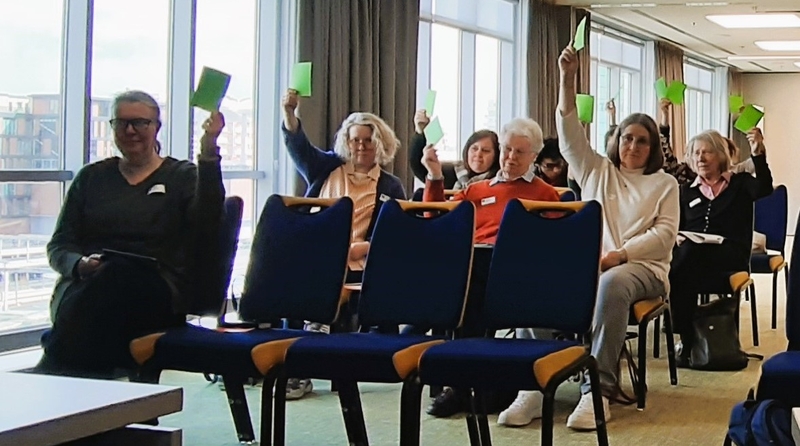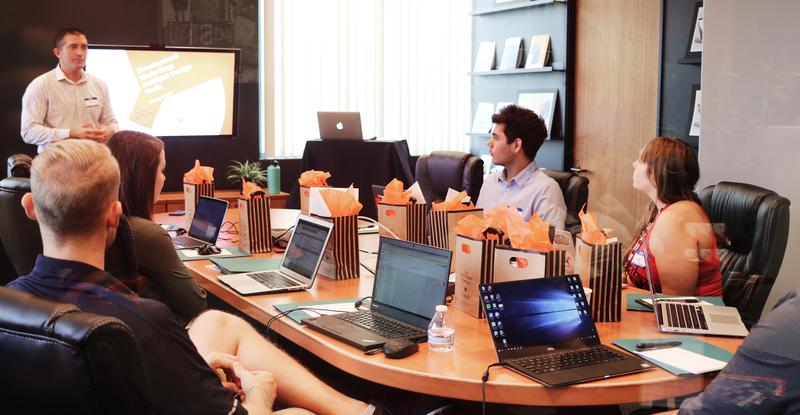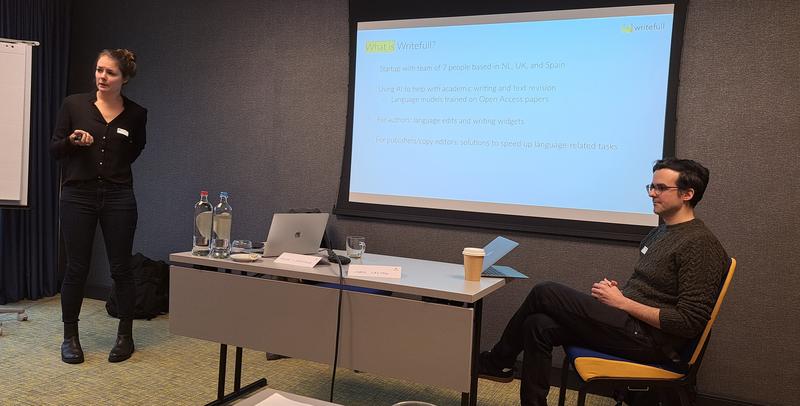Written by: Naomi Gilchrist
Published: 18 April 2023

When I was studying for my degree in translation, several teachers pointed out the benefits of joining a professional organization, and SENSE was one of the organizations whose name came up. I was eager to discover more about SENSE, so I registered to join the 2020 Jubilee Conference as a guest. Because of the pandemic, this event was moved online. I enjoyed everything that was on offer during the conference and I learnt a lot, so I decided to go ahead and become a member.
In the following years I attended many more online SENSE events, including the Annual General Meeting (AGM) in 2021 and 2022. The AGM of 25 March 2023 was the first in-person AGM in quite some time and it was also the first large in-person event for me. I had previously spoken to some SENSE members during various Zoom meetings and workshops, so I was excited to meet everyone face to face.
The ‘meet’ of the matter
Luckily, I had been to the meeting venue at Park Plaza before, so I did not have any trouble finding the place. The doors opened at 12:00, which gave members the opportunity to meet, catch up, and discover new books in a mini book-swap before the meeting started at 13:00 sharp.
During the meeting, we discussed the minutes of the previous AGM and the reports from the Executive Committee (EC) and Team Leaders. We also looked at SENSE’s new organizational structure and voted for the election and re-election of several members. After discussing the points that came up during the ‘Any Other Business’ portion of the meeting, we took some time to thank the retiring EC members and all other volunteers for their valuable contributions.
Despite the full agenda, we managed to end the meeting right on time. The minutes of the meeting will be shared with SENSE members at a later stage.
Wrapping up the day
After the meeting concluded, many of us stayed and joined a singing workshop. There was singing (now, I don’t think the teacher was extremely impressed with the vocal prowess of most of us, but I thought we sounded pretty good!) and there was even some dancing. I think we all enjoyed being able to move around a bit after having sat down all afternoon.
Some of us then went on to have some drinks at the hotel bar and a very nice meal at an Indian restaurant. All in all, I felt it was a productive and fun day.
|
Blog post by: Naomi Gilchrist LinkedIn: naomi-gilchrist-translator Twitter: NaoGil |

On Friday, 10 February 2023, Kenneth Quek, a Chinese Singaporean who lives and works in Helsinki as a freelance editor, spoke online to 18 UniSIG members. Coming from Singapore, a country with the third highest population density in the world, a multicultural society and a postcolonial past, he is familiar with the need to respect cultural identities.
During his talk, he first explained how important it is for the Chinese and Southeast Asians to establish a context. Perhaps you may have heard how when Chinese students are shown a photograph of a tiger in a forest, they focus on the context, the forest behind the tiger, whereas American students focus on the tiger itself. Kenneth told us that although those coming from different cultures might be acting in good faith, these differences in perception can cause misunderstandings to occur.
Cultural attitudes have implications when conducting business, and this can be traced back to Asia’s hierarchical culture. Age-related factors such as having seniority within a company or simply sporting a white beard inherently command respect. Needs and desires are culture-bound and Kenneth recommended that you first need to convince the Chinese and Southeast Asians to allow you to help them. In line with their cultural expectations he said, ‘you do a favour to get a favour’. He mentioned that ‘there’s an assumption that we’re going to run into this person again’ so we need to establish a rapport from the very start. He added, ‘It’s important to build trust in your relationships’.
Kenneth also referred to how the postcolonial historical context has coloured Asian people’s feelings in their relationships with Westerners. He remarked that ‘there’s a lurking sense that the West doesn’t have Asia’s interests at heart’. In his own country of Singapore, the British colonizers brought in Chinese labourers in order to maintain their power, fully aware that these indentured workers could easily be controlled through their high debt. It was not until 1963 that British rule on the island ended.
Unfortunately, there was little time left to exchange each other’s experiences in editing or teaching Asian students or to discuss our own encounters with Chinese and Southeast Asian clients. One SENSE member, who teaches in Switzerland, wrote in the Zoom Chat that she knows that her Chinese PhD students would never dare to disagree with her because of her age and position. Kenneth had exclaimed earlier that ‘you’re making it harder for them by asking them what they think’. Apparently, it is wise to come up with strategies you can employ in specific educational settings as otherwise you might make Asian students, or even clients, feel uncomfortable.
We were all surprised when, at the end of his talk, he remarked that if we were to remember one take-away, it would be that food is the best way to connect with Asian people. It seems that they take great pride in their regional cuisine. Moreover, Kenneth emphasized how necessary it is to find a common ground, and by sharing and talking about food we can achieve this goal. Apparently, in today’s rapidly changing globalized world, strategies are not only needed in the classroom, but in all cultural exchanges, with the hope that misunderstandings can be avoided and that cultural boundaries can be transcended.
|
Blog post by: Michelle Mellion Website: www.totheletter.nl LinkedIn: michelle-mellion-doorewaard |

Karen McMillan Tkaczyk (mcmillantranslation.com) is a Scottish chemist-turned-linguist with a Polish surname living in Colorado. Ever since meeting Karen at a UK translation conference back in 2011, I have found this a fascinating combination. And given her extensive experience as a French-English translator and trainer, I was pleased to hear she’d agreed to give an online workshop for SENSE. This was held on 15 November 2022 for a group of more than 25 SENSE members.
Spot the deliberate mistake
During the 2-hour session, Karen shared her principles for proofreading and editing (our own work and that of others) but she also dealt with pricing, and dealing with emergencies and tight deadlines. Karen kept us on our toes with ‘spot the deliberate mistake’ quizzes in between her other slides and used the chat to ask for our input, which kept things nicely interactive. A topic such as proofreading and editing naturally requires definitions, and Karen clarified from the start that she sees editing basically the same as revision (making changes to a text), and proofreading the same as copy editing (correcting obvious mistakes or style guide discrepancies).
If in doubt, don’t!
She also touched on client communication – that we should make sure to tell the client beforehand what we’re going to do, to avoid surprises. And she encouraged us to be aware of the difference between an improvement and a personal preference, and between a correction and a suggestion; the take-home message being ‘if in doubt, don’t!’ When correcting the work of others, during quality control or translation revision, Karen emphasized the importance of critiquing the process rather than the person.
Dragon breath
We also discussed software and other tools of the trade to help us spot mistakes and inconsistencies, and several participants indicated that they would be trying out some of Karen’s suggestions, including Xbench (quality assurance software for translators) and PerfectIt (consistency checker in Word). One term that I’d not heard of before was ‘dragon breath’, which she used to refer to mistakes arising in a text due to speech recognition software such as Dragon NaturallySpeaking. Conversely, text-to-speech software can be useful for discovering mistakes in your text by when you listen rather than read.
Per word, per hour or per project?
In terms of pricing, Karen discussed the pros and cons of charging a word rate, hourly rate or project rate – she has found that many of her clients accept a flat fee per project. Such a strategy has the advantage of fast work benefiting the word-worker rather than the client, but this may involve some negotiation.
Resources
After the workshop, in addition to sharing her slides, Karen sent us some extra resources: a document explaining her quality assurance procedure for translation, her checklist for editing a manuscript for a journal, and a document listing the resources she had mentioned during the session plus many more – these included lists of software, style guides, websites and training courses.
Given the limited time, I felt that Karen covered a lot of material that was useful both to translators and editors, with many of her tips also applying to copywriters. I hope that next time she is in Europe she will be able to give an in-person workshop for SENSE.
|
Blog post by: Sally Hill LinkedIn: sally-hill-nl Twitter: SciTexts |

John Lennon allegedly once said that life is what happens while you are busy making other plans. I suppose Mr Lennon was not thinking about lunch in particular, but it nevertheless seemed to apply to the Southern SIG lunch on 8 September 2022.
The conveners had originally planned to have two lunch events. Unfortunately, the first one had to be cancelled and the second one had to be unexpectedly relocated at fairly short notice. In the end, Southern SIG welcomed a grand total of four attendees to Maastricht.
Although it would have been nice to see more people, we had a wonderful time catching up and greatly appreciated the complimentary lunch, with a special mention to the carrot cake. Moreover, the upside of a modest gathering is that you can have a proper conversation with everyone present.
Before diving into the meeting’s topic of networking, we had a lovely chat about a vast array of subjects. Did you know, for instance, that one does not become a volunteer tour guide at the Victoria & Albert Museum overnight? In fact, new recruits have to start in the cloakroom and then work their way up the ranks before they are entrusted with the great responsibility of taking tourists around the museum!
We then discussed the importance of small talk. We shared a real-life example of a co-worker who never uttered a word, save for ‘good morning’ and ‘goodbye.’ It turned out the gentleman in question was not unwilling to strike up a conversation but did not know what to talk about. It would seem this is an ailment mostly suffered by men, although the cure is surprisingly simple – just try asking someone a question. If you are the silent type, you could ask them how their journey to work was or if they have any plans for the weekend. Before you know it, you will be engaging in small talk.
We also discussed networking and how conferences can be beneficial for your freelance business. As a language professional, you have plenty of annual conferences to choose from, but you should keep in mind that attending one can be a significant expense. Travelling to the venue, booking a hotel, the conference ticket itself, fringe events, meals and entertainment can cost up to a thousand euros. That said, it is a great way to meet like-minded language professionals and conference-goers are usually the friendly, outgoing type. However, you will not typically meet your next big client at a translators’ or editors’ conference. If you want to meet clients, you should consider attending their industry conferences, not yours.
If you are knowledgeable about a particular subject, it could also be interesting to give a lecture or workshop about it. This way you can showcase your knowledge to peers and you will meet colleagues with similar interests or skills, which may be interesting for future collaborations.
In summary, it was a productive and pleasant lunch and Southern SIG hopes to host more in-person events in the future.
|
Blog post by: Jasper Pauwels LinkedIn: jasperpauwels |

Sometimes you realise within the blink of an eye that someone understands you perfectly, even without having shared much of yourself. That’s the feeling I had when Susie Jackson answered a question of mine in her recent online workshop on setting prices. The workshop delved into the factors that freelancers should take into account when setting prices and was well-attended by SENSE members.
Now what was my question you might ask? I don’t remember it verbatim, but it concerned my first-ever paid blogging gig. Through participating in a workshop at my co-working space in Deventer, I had landed a paid writing assignment. As I was also working as a consultant, I hadn’t planned on working on a writing assignment. But it came about through a wonderful interaction with people I now call my friends. I think many freelancers will recognise this setting.
I had shared with Susie that I felt lucky to have the opportunity to write the blog, combining my love for writing and my PhD background in the political dimension of food and agriculture. And while that’s all very true, I will repeat this: I felt lucky to be able to write a blog on topics that I am beyond qualified to write about. Perhaps it comes as no surprise to you that Susie immediately ‘diagnosed’ me with impostor syndrome, but for those less familiar with the term: let me explain.
Impostor syndrome is generally considered as a collection of feelings of inadequacy. Future Learn offers a succinct yet comprehensive definition: ‘An internal experience and thought process believing that you are not as competent as others perceive you to be. It can affect anyone, no matter their social status, work background, skill set or expertise’. According to Psychology Today, it is more prevalent among women than men.
As you can imagine, experiencing impostor syndrome or its associated feelings has an impact. SENSE chair Sally Hill has written about this on the SENSE blog previously. What made Susie’s workshop so useful is that she connected underlying reasons and drivers to the process of setting prices, which is sometimes done without much critical reflection, following industry averages. If we don’t take time to stop and check, the emotions connected to a wider feeling of being out of place or performing above one’s level – even though misplaced – can have a direct impact on income.
For those who want to know more, you can follow the embedded links above and read Susie’s own blog about the topic, which contains many practical tips.
|
Blog post by: Justa Hopma Website: justahopma.com LinkedIn: justa-hopma Instagram: @justaschrijft |
[Image credit: slon.pics]

Having just joined SENSE and experienced the double whammy of the SENSE Annual Dinner and the online Orientation, I was asked to write this post to give a new member’s perspective of the Society.
Two style options were immediately apparent: that of the stream-of-consciousness EIMI by e e cummings or a listicle. Ill-advised neologisms aside, the former, more lifelike option might not quite get the information across. So a list it is.
1. SENSE is real
It is surely a modern ritual for new SENSE members: you join an online meeting expecting to find an instructor and a slide show, only to be confronted with a lively network of living, breathing human beings. Once the initial shock is over, it’s best (in my opinion) to attend an in-person event. That way you will feel more at ease at the next online meetup.
Luckily, new members were made to feel especially welcome at the SENSE Annual Dinner on 21 January. If you missed it, I highly recommend coming to the AGM in March. Think drinks, snacks, a bookswap and a (non-obligatory!) singing workshop. And a little bit of voting.
2. To SIG is holy
Did I say ‘meetup’? This compound noun, made from the informal phrasal verb ‘to meet up’ would likely awake the same scorn as ‘listicle’ might among some SENSE members. Instead we have ‘SIG’ or ‘Special Interest Group’. It’s basically a meetup, based on interest (Copywriting SIG, Tech SIG) or area (Utrecht SIG, Eastern SIG). There’s a special one for new members: Starters SIG.
3. It’s not just editors
SENSE: the Society of English Native Speaking Editors
(For SENSE members mentally adding hyphens here, we can quote Churchill: “One must regard the hyphen as a blemish to be avoided wherever possible”.)
As the Society now includes non-native speakers and non-editors, it can be difficult for the starter to make sense of SENSE. But the acronym is just too good to lose. Now just called ‘SENSE’, members include editors, translators, subtitlers, indexers, and others.
One of the hallmarks of SENSE members is that they work with the English language. They may write or revise texts written in English. Or train non-native speakers to write in a business context. Or translate from English to Dutch. Add to that an ample assortment of subject areas, and anyone working with the English language should be able to find like-minded colleagues in SENSE.
4. To be decided
At the online SENSE Orientation, new members were given a good grounding in the inner workings of the Society. We were encouraged to come along to SIG meetups, post on the ‘Introduce yourself’ section on the Forum, and to find a SENSE mentor. There was also an invitation to volunteer for various roles in the Society, from proofreading blog posts to becoming a Member-at-Large in the Executive Committee.
The invitation to get involved in volunteering for SENSE may have been a bit unexpected for some new members, just as the SENSE Annual Dinner sounded like something for established members. Happily, we got a lot of encouragement from existing SENSE members at both events and many promising contacts were made.
SENSE membership offers big rewards for new members – not least mentoring and a ready-made network of colleagues – and it will take more than a little impostor syndrome or blog writer’s block to stop us getting involved. To be decided: the future is in our hands.
|
Blog post by: Tomas Brogan LinkedIn: tomasbrogan |

On 9 December, David Barick gave an online presentation for the SENSE Ed SIG titled ‘Teaching Writing to Chinese Students’. A large number of members were on hand, most of whom had had a fair bit of experience either in teaching Chinese students or editing texts for Chinese clients. Below, David gives his account of this session.
We began by taking a quick look at a number of online discussions of this topic, in the form of screenshots. Before investigating what was said there in detail, I asked participants about their own experiences with Chinese authors, and to mention any typical issues in the chat. Comparison of these comments with the online discussions disclosed many similarities, which fell into two categories. First, personality characteristics and cultural differences played a significant role. Many people found Chinese students to be shy and reticent, not comfortable about expressing opinions, or at least when working in groups. Linguistically speaking, a number of well-known confusions came to the fore: Chinese has no articles or gender, and hardly any plurals. Verbs always have the same form, and tenses are only indicated by adding particles to other places in the sentence.
Having made our lists of possible sticking points, we then turned to our expert guest for the meeting. Lin Shang is a Chinese-born dentist who holds a PhD in dental science from the University of Amsterdam and is employed as an assistant professor at the Academic Centre for Dentistry Amsterdam (ACTA). She confirmed that many of the remarks being made could be applied to at least some of her compatriots, and told us about the difficulties she had experienced in adjusting to an English-speaking academic life in the Netherlands. We had overlooked some things, however. For example, Lin pointed out that she had a tendency to overload her sentences with too much information.
This led us to the next part of the session, in which we discussed how to approach giving feedback to these students in a way that took their feelings – in any case, as we ourselves perceive them – into account. As it happened, the first example we looked at from one of my own students, which was grammatically flawless, contained two enormously long sentences of the type Lin had described. In this case, at the time, I split the entire class into work groups to look at the long sentences and discuss various ways of subdividing them into shorter ones.
We then looked at two introductions to scientific articles that mirrored one another to some extent. The first one, which involved the optimization of a hospital procedure, was full of grammatical and linguistic errors of the type we had already mentioned. The student did have to be made aware of them, but the feedback she received also emphasized the fact that she had structured her writing very correctly.
The second introduction, by a psychologist, was about the ways in which Chinese parents can influence their children’s choice of friends. Here, the language use was excellent, but this was a very complicated subject which required a great deal of explanation of cultural attitudes. As a result, clarity suffered, and the overall structure of paper was quite jumbled. In this case, I approached the author separately in the Zoom chat during class and asked if she would like to discuss her work with me during the break. This was delicate, as I did not want to give the impression that the author was going to be scolded or reprimanded. Fortunately, it turned out she was happy to have the opportunity to meet with me, because she had already been working on the paper for a month and was still dissatisfied with the result. This led to a total restructuring of the paper.
SENSE members can view the PowerPoint slides for this session, as well as the Zoom chat, in the SENSE Ed section of the SENSE Forum, here.
|
Blog post by: David Barick |

On 13 March, Maha El-Metwally will give an online talk for SENSE on remote interpreting and its implications for interpreters. Although remote interpreting has been around since the 1970s, the pandemic gave it a boost and it has now become an integral part of an interpreter’s work. In this blog post she will tell us more about her work and what you can expect from her talk. Maaike Meijer spoke to Maha about her life as an interpreter.
Could you tell us a bit about yourself and your background as a language professional?
I grew up in Egypt, where I went to a bilingual school in which the languages of instruction were Arabic and English. Then French was added as a third language. My connection with languages continued at the university where I did a bachelor’s degree in English and comparative literature and economics.
After that, I started studying Dutch before moving to the Netherlands for my first master’s degree in international relations. Before becoming a freelancer, I spent ten years working for international organizations, which meant moving between different countries. I took this as an opportunity to work on my French and learn Bosnian.
How did you start remote interpreting?
In 2016, I concluded a master’s degree in training interpreters at the University of Geneva. The focus of my thesis was technology for interpreters. The same year, I attended my first American Translators Association conference and I learnt more about remote interpreting. As I was always interested in technology, I got in touch with some remote interpreting providers and I had the chance to test-drive their platforms. Between 2016 and 2020, I had already done some remote interpreting jobs. So, when the pandemic hit, and conference interpreters found themselves stuck at home with their contracts cancelled for the foreseeable future, I thought it would be a good idea to inform colleagues that an alternative existed. I started giving free webinars to colleagues in Italy, China and Egypt, and after that I started offering training dedicated to certain platforms: Interprefy, Interactio, VoiceBoxer and Zoom are some examples. The idea was that colleagues could start offering their services remotely after having had a hands-on training on different platforms.
What are some common issues interpreters run into when it comes to remote interpreting?
Any interpreter who has done remote interpreting would tell you that sound and video issues are a constant problem. Managing different devices at the same time can be stressful. Communicating with booth partners who are not with you in the same place is a challenge. Add to this the increase in recorded video messages instead of speakers attending live due to the difference in time zones, for instance. As video messages are often scripted and read out, the speed of the speaker in a video is usually much faster than normal speech. There is also the issue of the interpreting being recorded without the interpreters’ permission.
Are you interested in attending this talk and learning more about remote interpreting? Please go to our website to sign up.
|
Blog post by: Maaike Meijer LinkedIn: maaike-meijer |

SENSE’s Training SIG convenor, Stephen Johnston, writes:
We held the first Training SIG meeting on Wednesday November 16 via Zoom. The topic was ‘The difference between teaching and training’. Participants included seasoned trainers and teachers, as well as the usual variety of language professionals from a wide range of fields.
It was a lively discussion, with most in agreement that while there is overlap between teaching and training, teaching is usually theoretical, focusing on increasing students’ understanding of a subject, while training is more concrete, focusing on increasing participants’ skill sets in a professional setting.
We agreed that training also involves shorter speaking segments combined with plenty of hands-on exercises, usually given in one or two-day sessions as opposed to longer series of lectures across weeks or months.
One surprise did pop up: the addition of the idea of ‘coaching’, which led to interesting discussions about a series of single participant sessions instead of a group approach.
The fact that we had experienced trainers as well as those curious about moving into the field ensured that there were plenty of questions, which kept the conversation going easily.
The Training SIG will be meeting about 3-4 times a year, so stay tuned for upcoming sessions that will focus on issues such as:
• What makes a good workshop session?
• How do you pitch a workshop and negotiate a price?
• What do corporate businesses want? (with a guest speaker)
• What do educational organizations want? (with a guest speaker)
• What are the current and future trends in training (blended learning, etc.)?
• What’s the difference between ‘business English’ and ‘business writing’?
• What are ‘storytelling for business’ workshops?
If you're interested in future meetings of the Training SIG, please contact
[stock photo: Unsplash]

At the 11 November 2022 UniSIG meeting, 12 SENSE members met at Park Plaza Hotel in Utrecht to hear about Writefull from Dr Juan Castro (CEO of Writefull) and Dr Hilde van Zeeland (Chief Applied Linguist). Their presentation focused on the use of artificial intelligence (AI) to revise academic texts, as well as what Writefull can offer SENSE members as an AI-based editing tool.
Writefull’s team consists of seven people based in the Netherlands, the United Kingdom and Spain. According to Juan and Hilde, the software uses language models constructed using hundreds of millions of sentences derived from open-access papers, mainly in the field of bioscience, in order to provide solutions to speed up language-related tasks. Writefull uses natural language processing (NLP) to identify aberrations in typical English sentence constructions (length, word order, word choice, formal/informal, language accuracy and language use). Writefull began as a tool for students and researchers as a means of overcoming language barriers, and it is now used by several editing companies and publishers.
During the presentation, AI was discussed in terms of its merits, but it was also dissected and challenged. Not all editing tools are alike, of course, as PerfectIt, Grammarly, Trinka and others show, and some are more effective than others. We discussed how AI-based language editing may impact the individuality of writing styles.
The presenters noted that AI-based editing tools have uses in different tiers within the industry. For example, Writefull is currently used by publishers as a tool to streamline ‒ and perhaps reduce the need for ‒ human editing, thereby leading to lower overall overhead costs and opening a path to publication for many scholars with lower levels of English, such as Chinese-language authors. According to the Writefull team, their AI-based service can lead to lower immediate rejection rates, higher acceptance rates, quicker acceptance and fewer revision rounds for authors submitting a text to be published in a journal.

After the presentation, several of us had lunch with Juan and Hilde, where we continued to discuss the topic of AI and its increasingly prominent role in editing and translation. Writefull is just scratching the surface of the potential for AI-based writing tools. For example, the future of AI-based editing may include writing models tailored for specific professions; while this is not currently cost-effective, future versions of Writefull may diversify for user-specific writing tools.
UniSIG is grateful to Juan and Hilde for taking the time to show us what Writefull and AI-based editing tools can offer our members, and we look forward to future updates!
[Image: SENSE members Daphne Lees, Henriette Schoemaker and Charles Frink discussing what they’ve learnt.]








